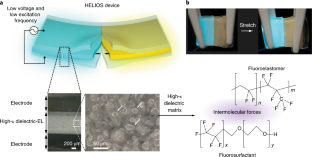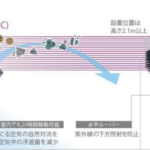(New stretchable, self-healing and illuminating electronic material for wearables and soft robots)
2020/5/31 シンガポール国立大学(NUS)

・ NUS が、自己修復可能でストレッチャブルな新しい光電子材料による、「HELIOS(Healable, Low-filed lluminating Optoelectronic Stretchable)」デバイスを開発。
・ ストレッチャブルな光電子材料は、ウェアラブルエレクトロニクスやソフトロボット、ヒューマン・マシンインターフェイス(HMI)等のアプリケーションにおいて不可欠なもの。
・ 同新材料は、フルオロエラストマーと界面活性剤を混合して作製した透明な弾性ゴムシート。高い誘電率を有するため、低電圧でもより多量に電荷を蓄える。発光コンデンサデバイスでの使用で、より高い光度を達成した。
・ 従来の光電子材料では、可視的な発光光度を得るための高電圧と高周波数のため、携帯性と作動寿命が制限されることに加え、HMI で安全に利用することが困難。
・ HELIOS デバイスは、従来の 1/4 の電圧で 20 倍の光度を提供。ストレッチャブル発光コンデンサでは最高となる、2.5V/μm で 1460cd/㎡の光度を達成(携帯電話のスクリーンに匹敵)。また、低電力消費のため作動寿命を延長し、HMI で安全に利用でき、ワイヤレス給電のため携帯性に優れる。
・ さらに、裂けや傷を受けた場合でも、同材料の分子間の可逆的な結合が切断・再形成するため、環境条件下において自己修復が可能。
・ 長期的に製造者と消費者のコストを節減し、電子廃棄物量やエネルギー消費量を低減する、耐久性とエネルギー効率性に優れた発光デバイスやディスプレイの製造は重要な意味を持つと考える。
・ HELIOS のアプリケーションは、耐損傷性で長寿命のワイヤレスディスプレイや、インドアスマート農業、宇宙開発や被災地で活躍する自律型ソフトロボット用の発光電子スキン等。低電力消費で自己修復する発光スキンが、長時間稼働しながら、暗闇で作業をするロボットに安全ライトを提供する。
・ 同材料について特許出願済み。今後は特殊包装、安全ライト、ウェアラブルデバイスや自動車、ロボティクスのアプリケーションに向け、同技術をスケールアップする。
URL: https://news.nus.edu.sg/research/new-stretchable-self-healing-and-illuminating-electronicmaterial-wearables-and-soft
<NEDO海外技術情報より>
(関連情報)
Nature Materials 掲載論文(アブストラクトのみ:全文は有料)
A transparent, self-healing and high-κdielectric for low-field-emission stretchable optoelectronics
URL: https://www.nature.com/articles/s41563-019-0548-4
Abstract
Stretchable optoelectronic materials are essential for applications in wearable electronics, human–machine interfaces and soft robots. However, intrinsically stretchable optoelectronic devices such as light-emitting capacitors usually require high driving alternating voltages and excitation frequencies to achieve sufficient luminance in ambient lighting conditions. Here, we present a healable, low-field illuminating optoelectronic stretchable (HELIOS) device by introducing a transparent, high permittivity polymeric dielectric material. The HELIOS device turns on at an alternating voltage of 23 V and a frequency below 1 kHz, safe operating conditions for human–machine interactions. We achieved a brightness of 1,460 cd m−2 at 2.5 V µm−1 with stable illumination demonstrated up to a maximum of 800% strain. The materials also self-healed mechanically and electronically from punctures or when severed. We further demonstrate various HELIOS light-emitting capacitor devices in environment sensing using optical feedback. Moreover, our devices can be powered wirelessly, potentially enabling applications for untethered damage-resilient soft robots.



